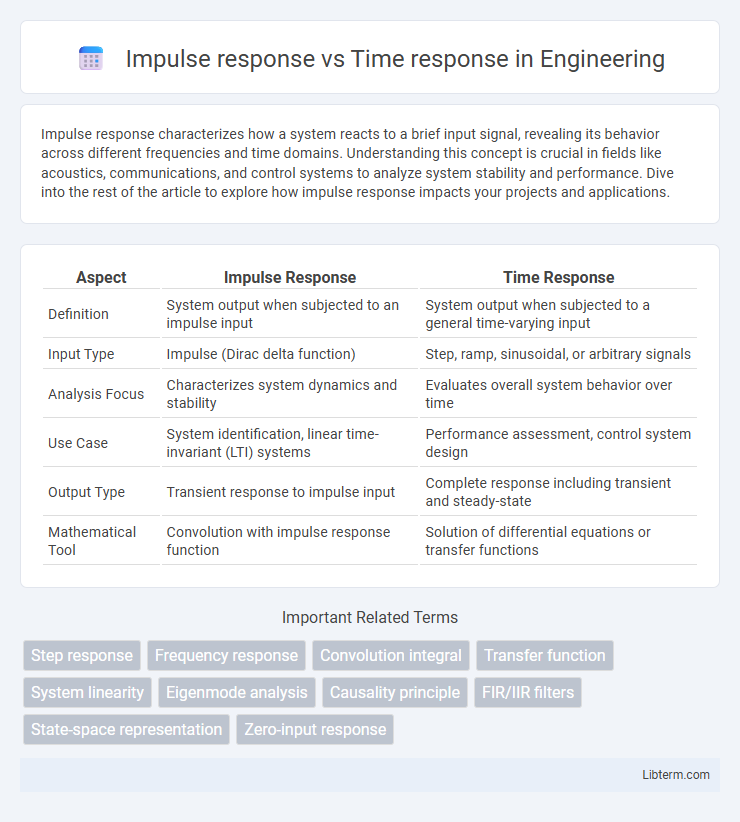Impulse response characterizes how a system reacts to a brief input signal, revealing its behavior across different frequencies and time domains. Understanding this concept is crucial in fields like acoustics, communications, and control systems to analyze system stability and performance. Dive into the rest of the article to explore how impulse response impacts your projects and applications.
Table of Comparison
| Aspect | Impulse Response | Time Response |
|---|---|---|
| Definition | System output when subjected to an impulse input | System output when subjected to a general time-varying input |
| Input Type | Impulse (Dirac delta function) | Step, ramp, sinusoidal, or arbitrary signals |
| Analysis Focus | Characterizes system dynamics and stability | Evaluates overall system behavior over time |
| Use Case | System identification, linear time-invariant (LTI) systems | Performance assessment, control system design |
| Output Type | Transient response to impulse input | Complete response including transient and steady-state |
| Mathematical Tool | Convolution with impulse response function | Solution of differential equations or transfer functions |
Introduction to Impulse Response and Time Response
Impulse response characterizes a system's output when subjected to a brief, instantaneous input, serving as a fundamental tool in system analysis and signal processing. Time response describes a system's output behavior over a period following any arbitrary input, capturing transient and steady-state dynamics. Comparing impulse response and time response helps in understanding system stability, control design, and dynamic behavior prediction.
Defining Impulse Response in System Analysis
Impulse response in system analysis represents the output of a dynamic system when subjected to a brief, instantaneous input signal known as an impulse. It characterizes the system's inherent properties and enables the prediction of the time response for any arbitrary input using convolution. This fundamental concept is essential for understanding system stability, frequency response, and control design in signal processing and control engineering.
Understanding Time Response in Dynamic Systems
Time response in dynamic systems characterizes how a system's output evolves over time when subjected to inputs, capturing transient and steady-state behaviors. It provides critical insights into system stability, speed of response, and overshoot, essential for control system design and analysis. Understanding time response enables engineers to predict system performance and optimize parameters for desired dynamic characteristics.
Key Differences Between Impulse and Time Response
Impulse response characterizes a system's output when subjected to a brief, instantaneous input signal, often modeled as a Dirac delta function, revealing its inherent dynamics and stability. Time response refers to the output of a system to any arbitrary input over time, providing insight into transient and steady-state behaviors. Key differences lie in their input types--impulse response uses a singular, short-duration input while time response involves continuous or variable inputs--and the scope of information, with impulse response serving as a building block for predicting overall time response through convolution.
Mathematical Representation of Impulse Response
The impulse response of a system is mathematically represented as the output signal when the input is a Dirac delta function, denoted d(t), capturing the system's complete dynamic characteristics. It is expressed as h(t) in continuous-time systems, derived by solving the system's differential equations with the delta function as input, serving as the fundamental solution. This impulse response function facilitates the computation of the system's time response to any arbitrary input through convolution integrals, linking h(t) directly to the system's behavior over time.
Time Response: Step, Ramp, and Other Inputs
Time response characterizes how a system reacts to various inputs such as step, ramp, and sinusoidal signals, providing insights into transient and steady-state behavior. Step inputs reveal the system's rise time, settling time, and overshoot, while ramp inputs highlight velocity error and steady-state tracking performance. Analyzing time response for diverse inputs enables engineers to predict system stability and design effective control strategies.
Significance of Impulse Response in Control Systems
The impulse response characterizes a control system's output when subjected to a brief, instantaneous input, revealing the system's inherent dynamics and stability properties. It serves as a fundamental tool for analyzing system behavior, enabling the prediction of time response to arbitrary inputs through convolution. Understanding the impulse response is crucial for designing controllers that ensure desired performance and robustness in various engineering applications.
Practical Applications: When to Use Each Response
Impulse response is ideal for analyzing systems in signal processing and control engineering where the system's reaction to a sudden input is critical, such as in filter characterization and system identification. Time response is more practical for evaluating overall system behavior over time, important in control system design, stability analysis, and transient response assessments. Choosing between impulse and time response depends on whether the focus is on instantaneous system dynamics or long-term performance evaluation.
Comparing System Stability: Impulse vs Time Response
Impulse response provides a clear examination of a system's stability by revealing how the system reacts to a sudden, short input, where a stable system exhibits a response that decays to zero over time. Time response analysis, including step response, evaluates stability by observing the system's output behavior to sustained inputs, ensuring the output remains bounded and converges to a steady state. Comparing these methods, impulse response offers precise insights into transient stability characteristics, while time response captures both transient and steady-state stability aspects.
Conclusion: Choosing the Right Analysis Method
Choosing the right analysis method depends on the specific goals and system characteristics; impulse response provides a clear, direct insight into the system's reaction to a brief input, ideal for understanding inherent dynamics. Time response analysis offers detailed information about how the system behaves over time with varying inputs, suited for evaluating performance under realistic operating conditions. Selecting the appropriate method enhances accuracy in system modeling, control design, and predictive maintenance.
Impulse response Infographic

 libterm.com
libterm.com